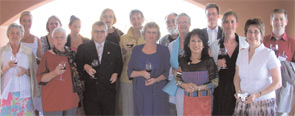Dr. Boers is concerned about losing flexibility in meeting organization, and he worries about mentoring new leaders for the process. “The number of participants has doubled, but the number of experts who really know how to run a workshop has not doubled,” he explains. “There is still a lack of seasoned experts to guide the process through. So, if you keep expanding, pretty soon the quality will go down.”
Another challenge: bringing OMERACT’s recommendations into the daily practice of rheumatology. Rheumatologists may recognize that use of outcomes measures is an essential part of good management, says Dr. Brooks, “but at the end of the day, very few of us actually know whether the treatments we are giving to patients are actually helping.” He urges practicing rheumatologists to learn more about the OMERACT order and to help their patients understand more about measurements and the drugs they are taking.
Summing up the OMERACT experience, Dr. Brooks says, “There are many things you do in life, and I think—and I suspect the others feel as I do—that this is something that we are all pleased about and proud of, that we’ve been a part of this movement.”
Gretchen Henkel writes the “Metrics in Rheumatology” series.
References
- Fried JB, Boers M, Baker PR. A method for achieving consensus on rheumatoid arthritis outcome measures: The OMERACT conference process. J Rheumatol. 1993;20(3): 548-551.
- Tugwell P, Boers M, Brooks P, Simon LS, Strand V, Idzerda L. OMERACT: An international initiative to improve outcome measurement in rheumatology. Trials. 2007;8:38.
- Kirwan JR, Hewlett SE, Heiberg T, et al. Incorporating the patient perspective into outcome assessment in rheumatoid arthritis—progress at OMERACT 7. J Rheumatol. 2005;32(11):2250-2256.
Patients as Research Partners
The need to include patients’ perspectives in the OMERACT research process was first acknowledged at OMERACT 5, held in Toulouse, France, in 2000, and patient representatives first attended as delegates at OMERACT 6, held in 2002 in Gold Coast, Australia. “When we had the first patient group,” recalls Dr. Brooks, “it opened our minds to looking at outcomes measures in a different way. After all, they are the people who have to do these measures and fill in the questionnaires. I don’t know of any other medical organization in the world that involves patients the way we do in measurement.” It was the participation of patients that led OMERACT to include fatigue as an outcome measure for RA.3

“Getting the patient perspective has been a neglected area,” says Dr. Saag. “We think we know what patients think is important, as we measure different aspects of their disease, but did we really ever bother to ask them?”
